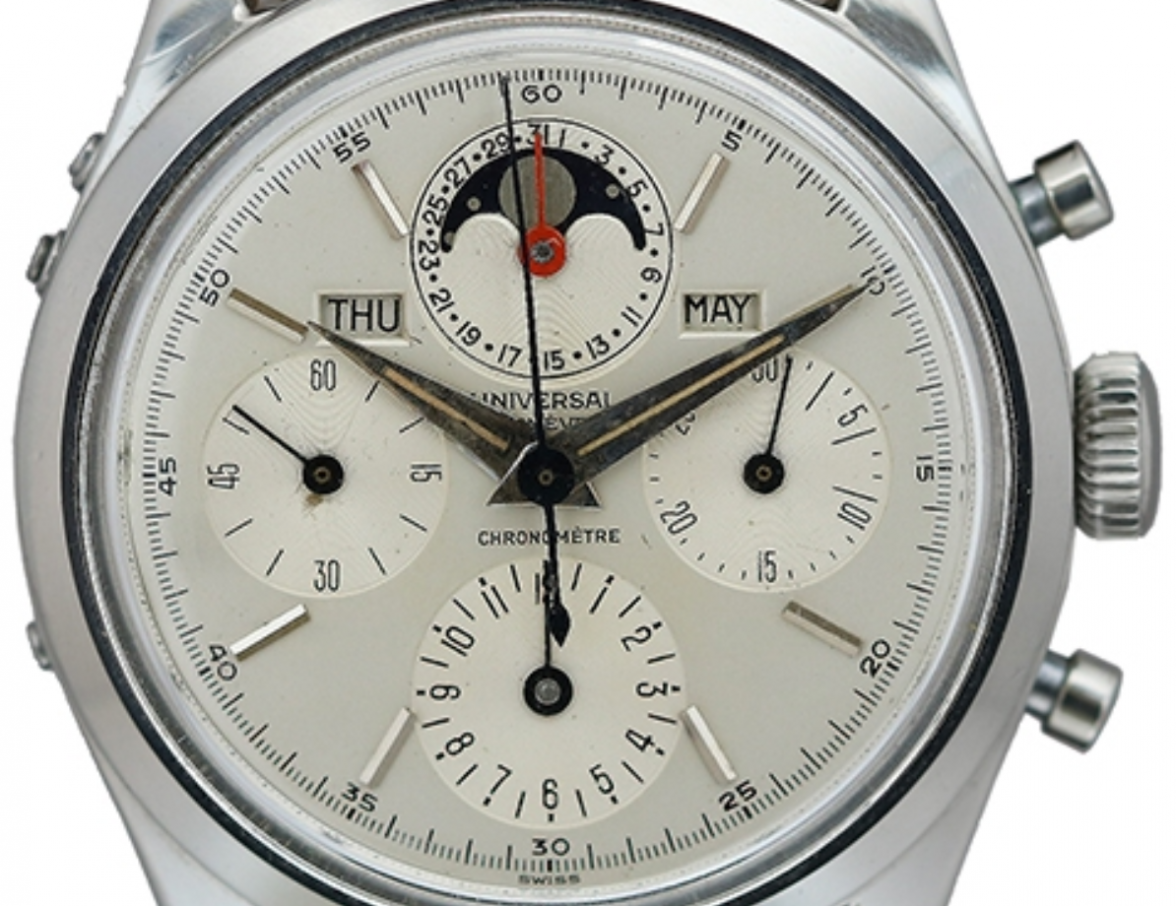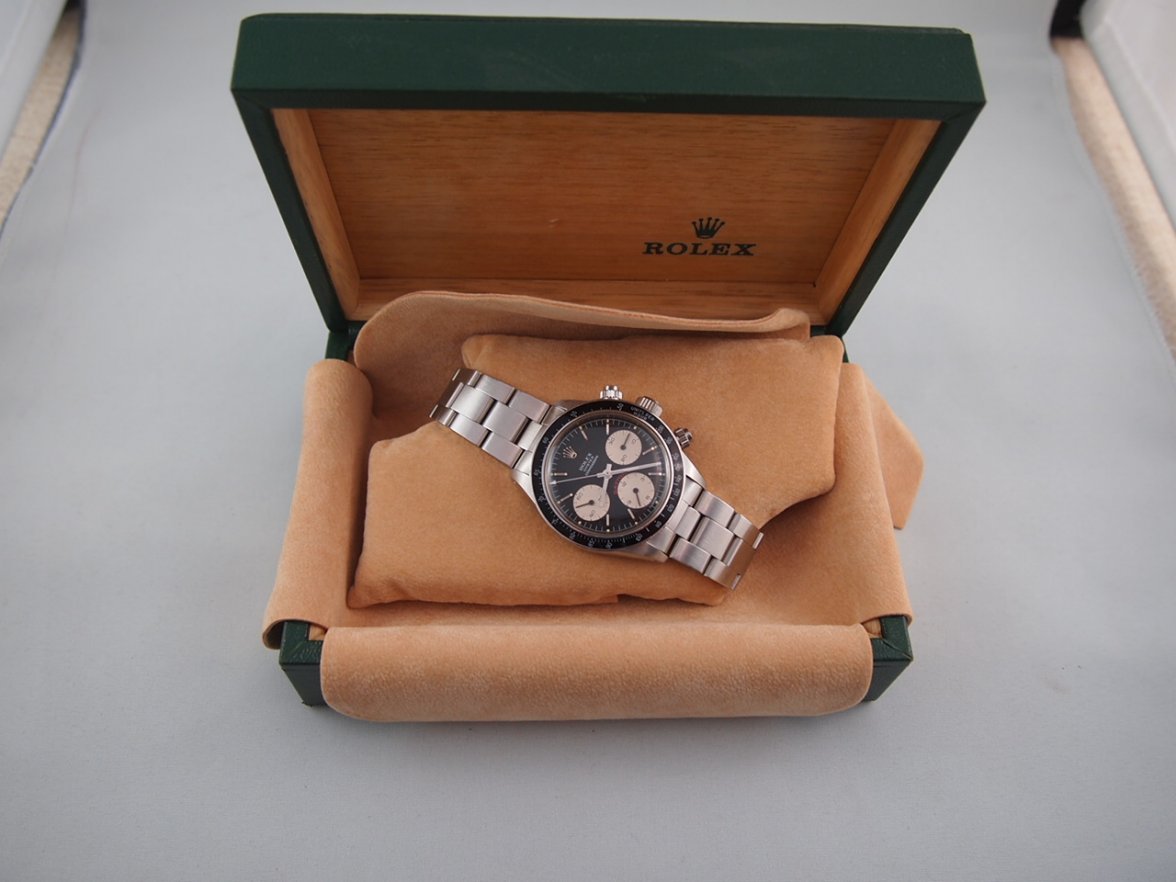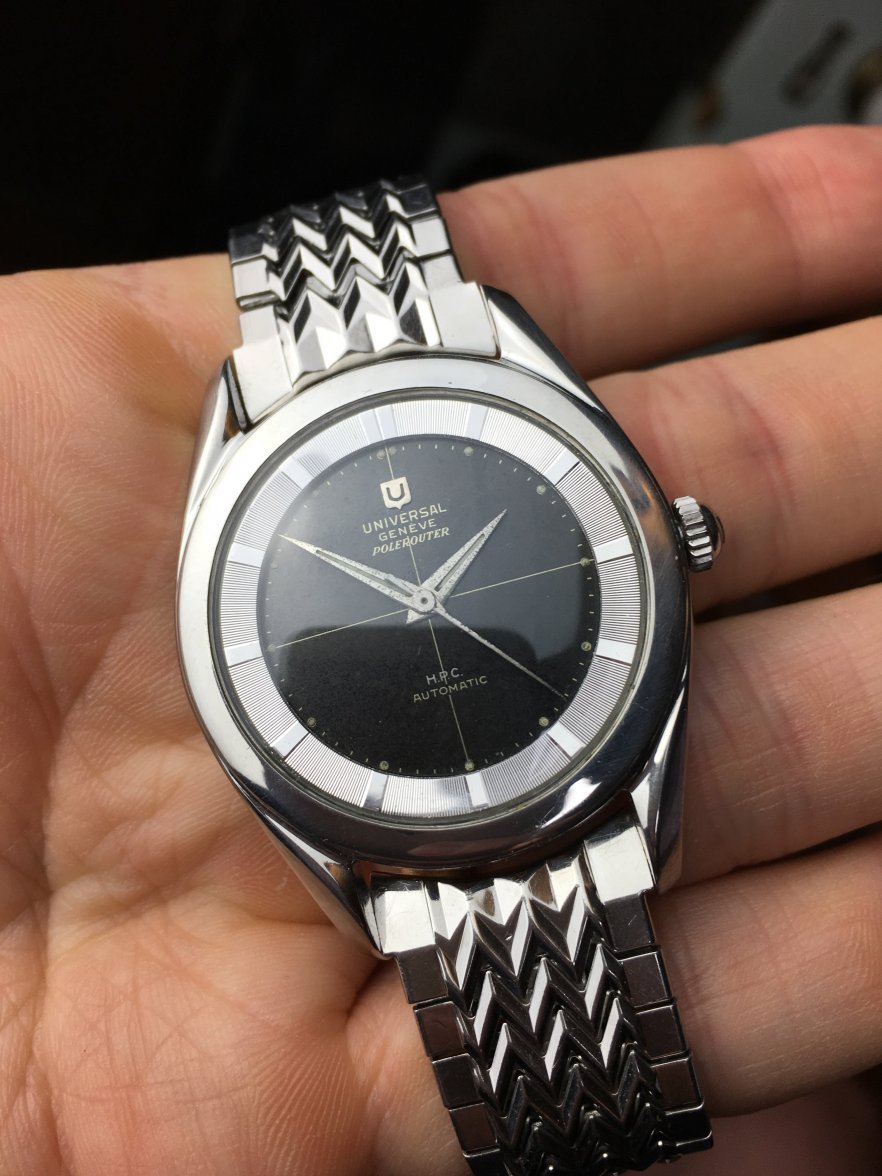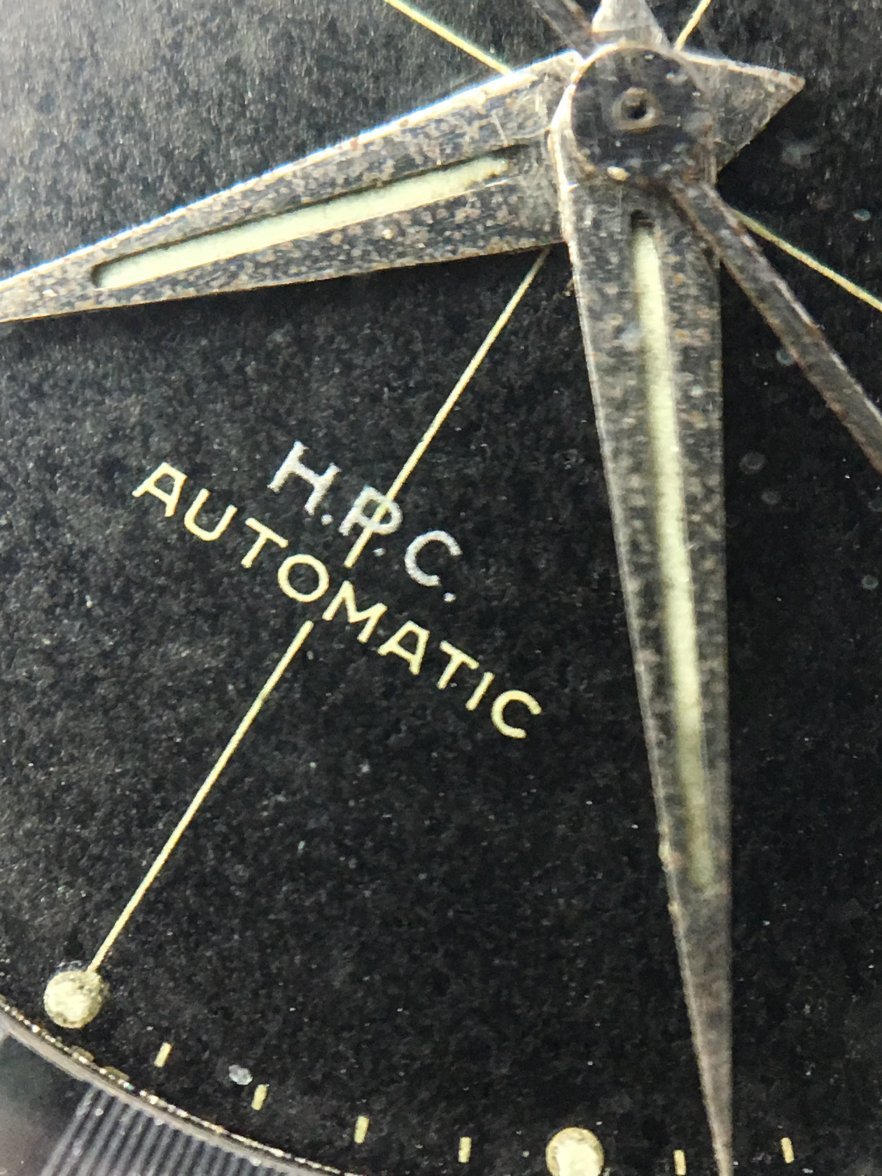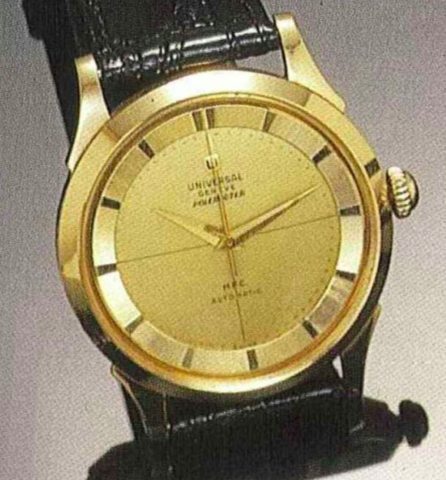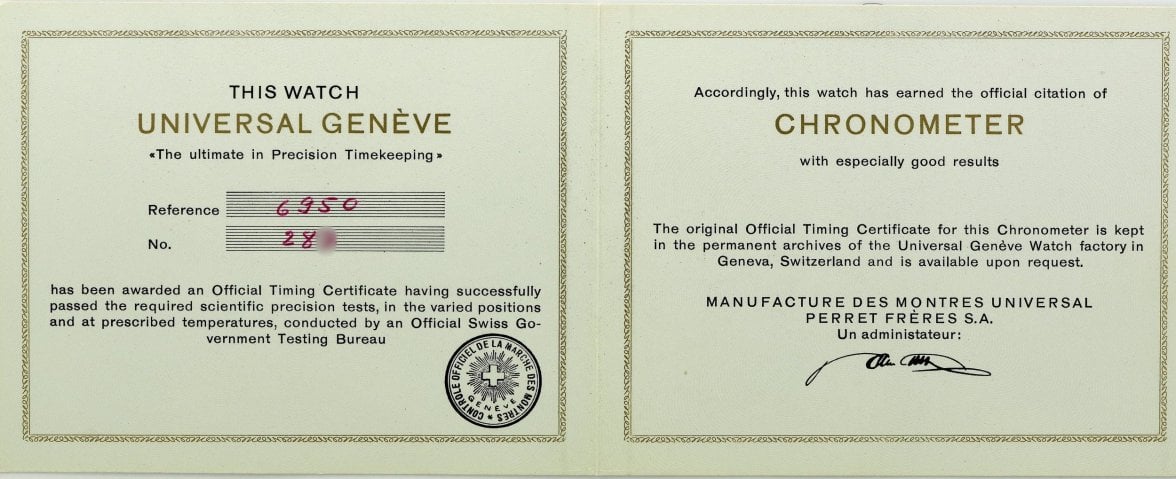Chronographs classified as Chronometres.
bgrisso
·Also odd there is no case serial
Edited:
Canuck
·Burr
·I don't believe I've seen another UG chronograph with a 'Chronometre' dial. The bridge is also marked 'unadjusted', which doesn't seem right. My understanding is that the whole point of chronometer certification is that the movement is adjusted to a certain degree of accuracy in a number of different positions.
I'm not a Tri-Compax expert but that looks like a 22297/3 rather than a 22297/2.
I'm rather doubtful about the whole thing.
I noticed the things you pointed out as well, but maybe there were exceptions made if this is a true chronometre Tri-Compax? This looks like a tough job to fake to me as the watch looks fairly legit and from a reputable watch dealer.
I’ve read that the other confirmed legit chronometre movements in UG watches do have “unadjusted” but those also aren’t chronograph movements and it past posts it sounds like people are comfortable that “HPC” chronographs can have movements with no special markings.
I’m saying all this to say that if this is legit, it may layout new rules for what a UG chronograph chronometre should look like as it sounds like it’s never been seen before.
Mazoue
·I noticed the things you pointed out as well, but maybe there were exceptions made if this is a true chronometre Tri-Compax? This looks like a tough job to fake to me as the watch looks fairly legit and from a reputable watch dealer.
I’ve read that the other confirmed legit chronometre movements in UG watches do have “unadjusted” but those also aren’t chronograph movements and it past posts it sounds like people are comfortable that “HPC” chronographs can have movements with no special markings.
I’m saying all this to say that if this is legit, it may layout new rules for what a UG chronograph chronometre should look like as it sounds like it’s never been seen before.
I just think there are too many concerns about the watch for it to be useful as evidence of anything. For example, the fact that the case reference number does not match the dial seems like a pretty serious issue.
I would like to hear what the Tri-Compax experts think about the dial.
Should we be able to see evidence of lume plots at the end of each hour marker? Should the hour markers overlap the bottom register? In the examples I can find, those hour markers are shaped so that they do not overlap the register.
Mazoue
·Ok, what do we think of the theory courtesy of @bgrisso that HPC on UG dials could actually stand for Henrique Pfeffer Caracas?
For the record, some initial discussion took place here https://omegaforums.net/threads/post-your-universal-geneves.40710/page-65#post-1382609
Whilst it would explain a number of anomalies e.g. HPC watches are not chronometers, I have a couple of reservations:
- Why would some dials be marked Henrique Pfeffer Caracas and others as HPC? As @bgrisso pointed out, why would a retailer not wish to use their full name?
- The only UG advert or literature I've seen that features an HPC dial is on page 224 of Sala and the text is French. Would we expect a UG advert to feature a retailer signed dial? If so, would we expect it to be in Spanish rather than French given that Spanish is spoken in Venezuela?
It would be very helpful to understand why Sala thought that HPC stood for High Precision Chronometre. Does anyone know him to ask?
For the record, some initial discussion took place here https://omegaforums.net/threads/post-your-universal-geneves.40710/page-65#post-1382609
Whilst it would explain a number of anomalies e.g. HPC watches are not chronometers, I have a couple of reservations:
- Why would some dials be marked Henrique Pfeffer Caracas and others as HPC? As @bgrisso pointed out, why would a retailer not wish to use their full name?
- The only UG advert or literature I've seen that features an HPC dial is on page 224 of Sala and the text is French. Would we expect a UG advert to feature a retailer signed dial? If so, would we expect it to be in Spanish rather than French given that Spanish is spoken in Venezuela?
It would be very helpful to understand why Sala thought that HPC stood for High Precision Chronometre. Does anyone know him to ask?
Vitezi
·For a retailer, having your name printed next to the manufacturer branding on the watch dial is a form of affinity marketing.
The manufacturer is essentially saying that it values that particular retailer relationship enough that it is willing to co-brand the watches sold through that channel. The retailer would want to take maximum advantage of that opportunity by using its full name (as large as possible 😀) on those exclusive watches, rather than hiding behind an acronym. I am sure Henrique Pfeffer fully understood that.
The manufacturer is essentially saying that it values that particular retailer relationship enough that it is willing to co-brand the watches sold through that channel. The retailer would want to take maximum advantage of that opportunity by using its full name (as large as possible 😀) on those exclusive watches, rather than hiding behind an acronym. I am sure Henrique Pfeffer fully understood that.
MarktheTime
·Ok, what do we think of the theory courtesy of @bgrisso that HPC on UG dials could actually stand for Henrique Pfeffer Caracas?
For the record, some initial discussion took place here https://omegaforums.net/threads/post-your-universal-geneves.40710/page-65#post-1382609
Whilst it would explain a number of anomalies e.g. HPC watches are not chronometers, I have a couple of reservations:
- Why would some dials be marked Henrique Pfeffer Caracas and others as HPC? As @bgrisso pointed out, why would a retailer not wish to use their full name?
- The only UG advert or literature I've seen that features an HPC dial is on page 224 of Sala and the text is French. Would we expect a UG advert to feature a retailer signed dial? If so, would we expect it to be in Spanish rather than French given that Spanish is spoken in Venezuela?
It would be very helpful to understand why Sala thought that HPC stood for High Precision Chronometre. Does anyone know him to ask?
Mazoue
·First, I'll give @bgrisso big props for "thinking outside the box," but the theory seems highly unlikely to me for the reasons mentioned (retailers would want their full signature, etc). Secondly, if you are so inclined, you can try to contact Mr. Sala directly...he sells on eBay as user Salgari2017. Contact him as if you were inquiring about one of his listings. His English isn't that great, from what I recall of a brief exchange I had with him a couple of years ago when I ordered his wonderful UG reference book. Let us know if/how he replies!
I did send him an e-mail a few months ago (in Italian and English) but didn't get a response. I don't blame him of course, we don't always have time to respond to ad hoc e-mail queries from strangers.
I was just hoping that someone here knew him and might be able to ask him as a friend.
bgrisso
·Ok, what do we think of the theory courtesy of @bgrisso that HPC on UG dials could actually stand for Henrique Pfeffer Caracas?
For the record, some initial discussion took place here https://omegaforums.net/threads/post-your-universal-geneves.40710/page-65#post-1382609
Whilst it would explain a number of anomalies e.g. HPC watches are not chronometers, I have a couple of reservations:
- Why would some dials be marked Henrique Pfeffer Caracas and others as HPC? As @bgrisso pointed out, why would a retailer not wish to use their full name?
- The only UG advert or literature I've seen that features an HPC dial is on page 224 of Sala and the text is French. Would we expect a UG advert to feature a retailer signed dial? If so, would we expect it to be in Spanish rather than French given that Spanish is spoken in Venezuela?
It would be very helpful to understand why Sala thought that HPC stood for High Precision Chronometre. Does anyone know him to ask?
I had the same thoughts and went digging thru Sala to find any HPC examples and saw that one advert. I also find it unlikely that UG would advertise co branding, plus there is the language issue. One the other hand, who knows. One thing that I find very odd is I don't think we have a single HPC example in any archival photos in Sala? That doesn't make any sense to me.
I had the same question, where did Sala get his HPC info and why? Would be great if someone is in touch with him to find out.
While it seemed like a flash of inspiration when it first popped in my head, it seems less plausible in retrospect.
I wish we could crack this one! So far we are otherwise left with HPC being a meaningless designation that was sparingly applied to dials, with no corresponding movement characteristics? That seems pretty thin as well?
Vitezi
·Are there any records available from the various Bureaux Officiels de Contrôle de la marche des montres offices that existed until 1973?
(a sort of archival pre-COSC database, such as the one that the Neuchatel Observatory released in 2017)
(a sort of archival pre-COSC database, such as the one that the Neuchatel Observatory released in 2017)
- Posts
- 257
- Likes
- 155
Moahunter
·I've been racking my brain thinking what else HPC could mean.
I assume it would be a phrase in French and of course this would accord with our current High Precision Chronometer - Haut Precision Chronometre, I've been lazy and omitted the accents.
But I have to admit I'm stumped.
I assume it would be a phrase in French and of course this would accord with our current High Precision Chronometer - Haut Precision Chronometre, I've been lazy and omitted the accents.
But I have to admit I'm stumped.
bgrisso
·One thing that makes this difficult is we have never come across any HPC anywhere in adverts, literature, manuals, etc, aside from the one ad on page 224 in sala. We need to find some documentation in UG printed materials.
Again, it's very odd that not a single HPC example in the archival photos in Sala, just statistically you would think at least one would show up.
Have we ever made a list of which calibers and/or models we have seen HPC dials? I'm not sure what that would tell us, but maybe we can start looking for patterns.
Have we ever seen a black dial HPC? Not that this matters, but I've never seen one myself.
Again, it's very odd that not a single HPC example in the archival photos in Sala, just statistically you would think at least one would show up.
Have we ever made a list of which calibers and/or models we have seen HPC dials? I'm not sure what that would tell us, but maybe we can start looking for patterns.
Have we ever seen a black dial HPC? Not that this matters, but I've never seen one myself.
Mazoue
·Have we ever seen a black dial HPC? Not that this matters, but I've never seen one myself.
Yes, I have a black S20217/4 bumper Polerouter. This is the only entirely authentic HPC marked Polerouter I have ever seen.
The only other HPC Polerouter dial is on the watch pictured below. I am fairly certain it is a franken though as the case reference is 100105, which is a Monodatic reference, and it has a Cal 138c, which is not a Polerouter movement.
The dial looks correct though and is almost certainly from an S20217/2 bumper Polerouter originally.
- Posts
- 257
- Likes
- 155
Moahunter
·A recent thread on UG 28 Chronometer includes a post by Mazoue bringing to our attention another example of this model https://www.vesperco.com/soldwatches/universal-geneve-chronometer-28.
Interestingly there is a pic of the Chronometer cerification
Unfortunately there is no pic of the movement so we have no idea what might be inscribed on it.
Note the phrase "Certificate of High Precision" used in the description and the final pic.
Might HPC mean High Precision Certified?
Interestingly there is a pic of the Chronometer cerification
Unfortunately there is no pic of the movement so we have no idea what might be inscribed on it.
Note the phrase "Certificate of High Precision" used in the description and the final pic.
Might HPC mean High Precision Certified?
Mazoue
·High Precision Certified is very plausible but it still leaves us with the same old problem; the HPC watches were not chronometers.
The two examples above both have dials marked 'Chronometre' and have the chronometer certification papers. They would have had serialised movements.
I think we have seen more than enough examples of watches with dials marked 'HPC' without serialised movements to conclude with a high degree of certainty that these watches did not start life with serialised movements and were never therefore certified chronometers. It also makes little sense for there to have been two different dial designations, 'Chronometre' and 'HPC', that both meant the same thing.
So if High Precision Certified is correct then we're back to thinking that HPC was largely marketing jargon.
Personally, I think High Precision Certified is more likely than High Precision Chronometre because Chronometre has a particular meaning and it would seem unlikely that UG would use the term if they were not actually chronometers.
The two examples above both have dials marked 'Chronometre' and have the chronometer certification papers. They would have had serialised movements.
I think we have seen more than enough examples of watches with dials marked 'HPC' without serialised movements to conclude with a high degree of certainty that these watches did not start life with serialised movements and were never therefore certified chronometers. It also makes little sense for there to have been two different dial designations, 'Chronometre' and 'HPC', that both meant the same thing.
So if High Precision Certified is correct then we're back to thinking that HPC was largely marketing jargon.
Personally, I think High Precision Certified is more likely than High Precision Chronometre because Chronometre has a particular meaning and it would seem unlikely that UG would use the term if they were not actually chronometers.
Vitezi
·So if High Precision Certified is correct then we're back to thinking that HPC was largely marketing jargon.
I speculate that HPC watches were ordinary watches that had been timed at the factory, obtained especially good results, were issued with a Certificate of High Precision along with a special dial marking, but were not chronometers. HPC watches may even have been five-position-adjusted to obtain those good results but not marked as such. I'll bet UG charged a premium for HPC watches over ordinary unmarked watches.
Edited:
bgrisso
·I believe that certificate is a strong indicator of this. Consider that UG could have used any number of phrases to title that certificate, such as "Chronometre Certificate" or "Official Timing Certificate." However, UG specifically chose the title phrase "Certificate of High Precision" which means the Company likely used that term in-house. It meant something to them.
I speculate that HPC watches were ordinary watches that had been timed at the factory, obtained especially good results, were issued with a Certificate of High Precision along with a special dial marking, but were not chronometers. HPC watches may even have been five-position-adjusted to obtain those good results but not marked as such. I'll bet UG charged a premium for HPC watches over ordinary unmarked watches.
It's a reasonable enough theory, I think it's more or less where we have been at for a while, going in circles without supporting evidence. Most if not all HPC watches have movements marked unadjusted and without serial. It seems a little odd to go through the trouble of timing (and potentially multi position adjusting them) without bothering to indicate so on the movement, unless they were just timing all the mvmts, and the ones that happen to pass with flying colors they paired with HPC dials, after timing them?
Would they normally time the movements alone, or after they are paired with dials and cased?
If they did time all the movements alone, and anything that passed in house accuracy specs became HPC, it would be great to see a HPC watch paired with a HPC certificate (never seen this) and also to see any example of HPC in the UG literature (sales, brochures, price lists, etc.
- Posts
- 257
- Likes
- 155
Moahunter
·Perhaps HPC watches were better than average but did not perform at the same level of accuracy as Chronometers?
Why have we never spotted that "High Precision Chronometer" is a tautology? A chronometer is high precision.
Why have we never spotted that "High Precision Chronometer" is a tautology? A chronometer is high precision.

